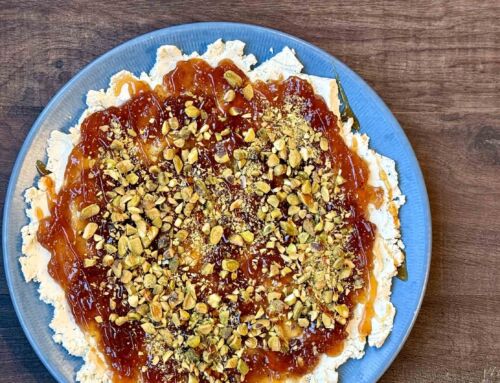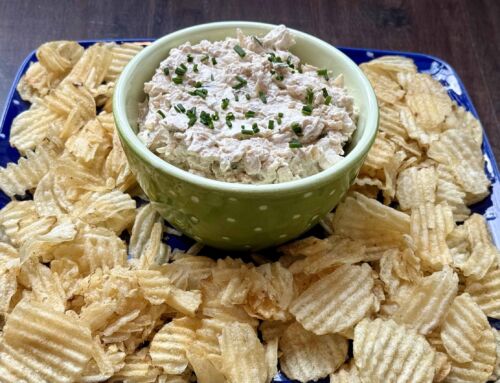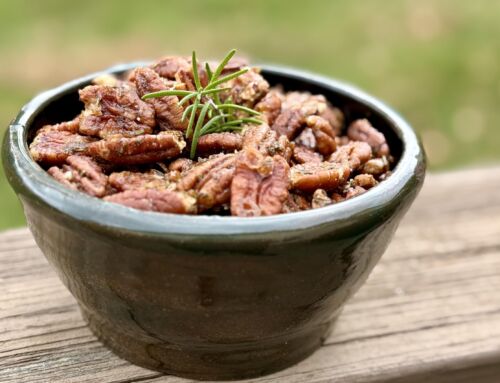No chickpeas were harmed in the making of this ‘hummus.’ Hence the usage of quotes.
The word hummus comes from the Arabic word ‘ḥummuṣ’ meaning ‘chickpea.’ I wasn’t sure if perhaps it fell into the category of a more generic term, such as ‘pesto’ which means to pound with a mortar and pestle. Pesto doesn’t have to be made with basil although that’s what we typically think of. Thank you for allowing my etymological digression.
While there are many ingredients in this dip that you would find in traditional hummus such as garlic, tahini, lemon juice and cumin, the main ingredients are roasted cauliflower and plain Greek yogurt. When they are all mixed together in a food processor the consistency is very similar to hummus as is the flavor profile.
Dr. Christine Wear perfected this low carb alternative and included the recipe in her new cookbook, Fresh & Flavorful Lean & Green Cookbook (2024). She shares that roasting both the cauliflower and garlic is the secret to the deep flavor and smoothness.
I’m a big fan of roasting garlic but I have only ever roasted a whole head. For this recipe, I roasted only the cloves I needed. They roasted in about the same time as the cauliflower. I do recommend checking the garlic a bit before the cauliflower is done depending on the size of the cloves.
We served this to our friends, Ray and Allyson B, who also agreed that this is a good alternative to hummus made with chickpeas. Allyson called it ‘hummiflower’ which is a perfect description.
In keeping with the low carb profile, I served this with an assortment of raw vegetables (carrots, celery and cucumbers) but it would also pair nicely with fresh pita or pita chips.
| Roasted Cauliflower Hummus | | Print |
- 1 medium head of cauliflower (~ 2 pounds), cut into small florets
- 6 medium garlic cloves, skins removed
- 5-1/4 teaspoons extra virgin olive oil, divided
- 10 to 12 ounces plain nonfat Greek yogurt (see Notes)
- 2 tablespoons tahini
- 2 tablespoons fresh lemon juice
- 1 teaspoon cumin
- Kosher salt and freshly ground black pepper
- 1 tablespoon pine nuts, roasted
- Garnish with a drizzle of extra virgin olive oil
- Serve with raw vegetables and/or pita chips
- Preheat the oven to 400°F. Line a large baking sheet with parchment paper.
- Add cauliflower to a large bowl and toss with 2 teaspoons extra virgin olive oil. Season with Kosher salt and freshly ground black pepper.
- Place garlic cloves on a small piece of aluminum foil and drizzle with ¼ teaspoon extra virgin olive oil. Wrap aluminum foil around garlic to form a packet.
- Place cauliflower and garlic packet on a prepared baking sheet.
- Bake for 30 to 35 minutes until the cauliflower is golden brown and cooked through, and the garlic is soft. You may want to check the garlic sooner than 30 minutes.
- Let cauliflower and garlic cool for 15 minutes. (Alternatively, you can prepare the cauliflower and garlic up to a day in advance. Store in the refrigerator.)
- Place cauliflower, garlic, yogurt, 3 teaspoons extra virgin olive oil, tahini, lemon juice and cumin in the bowl of a large food processor. Pulse to combine and scrape down the sides with a rubber spatula.
- Process for an additional 2 minutes until smooth, adding a bit of warm water as needed. Season with Kosher salt and freshly ground black pepper.
- Transfer to a covered container and store in the refrigerator until ready to serve. Dip keeps for 3 days.
- Remove from the refrigerator 30 minutes prior to serving. Transfer to a shallow bowl, drizzle with extra virgin olive oil and sprinkle with pine nuts. Serve with raw vegetables and/or pita chips.
Source: Adapted from Dr. Christine Wear’s Fresh & Flavorful Lean & Green Cookbook (2024)
Discover more from Riegl Palate
Subscribe to get the latest posts sent to your email.







I love the etymological digression and this recipe! Big fan of the cauli, yet never considered subbing the chickpea in some hummus. Will have to try with an almond yogurt and see how it goes. Drooling over here, once again!
Spenser – I appreciate you allowing me my digression! I’ll be curious to hear how the almond yogurt works.